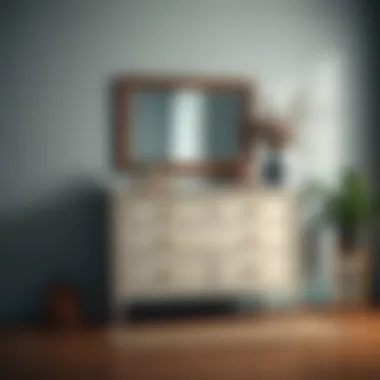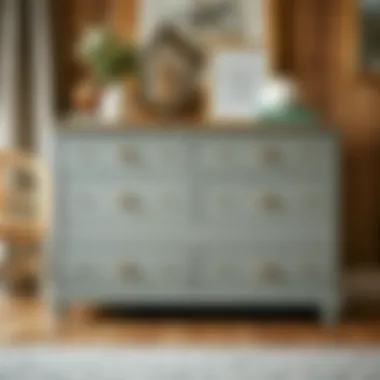Transforming an Unfinished Six-Drawer Dresser


Intro
When it comes to choosing furniture, unfinished pieces are often overlooked, yet they hold a treasure trove of opportunities for homeowners and design enthusiasts. A six-drawer dresser, for example, offers not just storage but also an adaptable canvas for your creativity. It's like having a blank page in a journal, waiting to be filled with colors, styles, and personal touches. The untapped potential of these dressers goes beyond their physical form; it invites you to explore a world of customization and practical applications in your living spaces.
This guide aims to unravel the multi-dimensional aspects of an unfinished six-drawer dresser. From understanding the current design trends to practical tips on maintaining your piece, it serves as an essential companion, assisting you in transforming this basic structure into a stylish and functioning element of your home. Let's dive in and discover how to unlock its full potential.
Design Trends
Current Trends in Furniture Styles
The landscape of furniture design is ever-evolving, and as trends come and go, unfinished furniture remains a steadfast choice. Its raw character allows it to fit seamlessly within various styles—be it rustic, contemporary, or even industrial. One prevalent trend is the shift towards minimalism. This aesthetic often champions simplicity over extravagance, emphasizing clean lines and natural materials. An unfinished dresser embodies this ideology, providing a backdrop that can easily blend into minimalist settings while allowing for custom modifications to enhance its appeal.
Another notable trend involves the incorporation of sustainability. Consumers today are more conscious about their environmental footprint. Unfinished dressers are typically constructed from solid woods, which are not only durable but can also be refinished and repurposed, reducing waste and promoting a greener lifestyle.
How to Incorporate Trends into Your Space
Transforming an unfinished dresser to align with contemporary trends invites a bit of imagination. Here’re a few suggestions to consider:
- Finish Options: Stain, paint, or leave it natural. A light stain can highlight the wood’s grain, while bold colors can make a statement.
- Hardware Choices: Swapping out standard knobs for unique vintage options can instantly change the dresser's personality.
- Accessorization: Use decor items, such as potted plants or framed pictures, on top of the dresser to create visual interest and complement surrounding decor.
These small changes can breathe new life into your dresser, aligning it with the current design ethos while still showcasing its original charm.
Buying Guides
Choosing the Right Furniture for Different Rooms
When selecting an unfinished six-drawer dresser, it’s paramount to consider the room's function and aesthetic. A living room dresser might be used for displaying books and personal items, while a bedroom piece primarily serves as storage. Think about the size of the space too—what might work in a snug area may feel cramped in a larger room.
Tips for Assessing Quality and Value
When investing in an unfinished piece, you’ll want to ensure it meets your expectations for durability and craftsmanship. Here are some points to examine:
- Material: Look for solid wood over particle board, as this ensures longevity.
- Construction: Check the joints; dovetail joints often indicate better quality.
- Finish Quality: Ensure there are no rough patches that could hinder your staining or painting process.
Assessing these aspects will not only help in making a wise purchase but also enhance the overall satisfaction with your furniture piece.
"Unfinished furniture provides an exciting opportunity for personalization and creativity, transforming a standard piece into a reflection of your style."
Prologue to Unfinished Furniture
The concept of unfinished furniture has gained traction in recent years, especially among homeowners and design enthusiasts who appreciate the raw beauty of materials and the creative freedom that this category offers. Unfinished furniture refers to pieces that are not pre-treated with paint or stain, allowing buyers to customize them to their preferences. This flexibility stands at the core of its appeal, as individuals can tailor the item to match their unique vision for their space.
When exploring an unfinished six-drawer dresser, it's vital to consider how such furniture can transform not just the look of a room, but also serve practical purposes. Many find themselves drawn not only to the aesthetics of an unfinished piece but also its potential utility. With more people seeking ways to personalize their homes, unfinished furniture presents an inviting canvas for creativity, making it essential to delve into its underlying benefits and possibilities.
Defining Unfinished Furniture
At its core, unfinished furniture is any item made from raw materials that hasn't undergone any finishing processes. This can include wood pieces that are sanded but left unpainted or unstained, giving the buyer the opportunity to apply their own vision. Typically crafted from quality hardwood such as pine or oak, it exudes a certain charm that complete pieces often lack.
One significant advantage of unfinished furniture is sustainability. Because these items bypass many of the chemical treatments and finishes used in commercial furniture production, they are often better for indoor air quality and the environment. This is particularly appealing to those who prioritize health and ecological considerations in their living spaces.
The Appeal of a Six-Drawer Dresser
The six-drawer dresser is a staple in many households, representing a blend of style and functionality. Unfinished, it becomes a versatile piece that can fit various decor themes, from rustic to contemporary. The lack of initial finishing allows individuals to either embrace the natural wood grain or opt for bold colors or techniques that speak to their personal style.
Moreover, practicality is at the heart of this furniture piece. The six drawers provide ample storage space while retaining a sleek profile, making it ideal for compact areas like bedrooms or home offices. By allowing for engagement with the material in its raw state, unfinished dressers encourage experimentation, transforming a simple piece of furniture into a functional work of art.
"Unfinished furniture isn’t just a purchase; it’s an investment in your personal creativity and a reflection of your personal style."
In summary, the allure of unfinished furniture—especially pieces like the six-drawer dresser—lies in their potential for personalization, combined with practical functionalities that meet modern-day living needs. By understanding these fundamentals, homeowners and enthusiasts can truly unlock the capability of these furniture items in their spaces.


Design Aspects of an Unfinished Six-Drawer Dresser
The design of an unfinished six-drawer dresser is not merely about its visual appeal; it's a combination of craftsmanship, materials, and functionality that can make a significant difference in your living space. This section emphasizes why understanding the design aspects of such a piece is crucial. These considerations can enable homeowners, designers, and DIY enthusiasts to appreciate not just the surface of the furniture, but also its potential when executed thoughtfully.
Craftsmanship and Materials
The backbone of any furniture piece lies in its craftsmanship and materials. An unfinished six-drawer dresser often uses solid wood, particleboard, or a combination of both. Solid wood, such as pine or oak, brings durability and a timeless aesthetic. On the other hand, more affordable options like plywood can offer versatility without breaking the bank.
The artistry of creating these dressers plays a significant role in their usability and lifespan. Handcrafted elements in the joinery, such as dovetailing, can enhance strength and stability. A well-assembled dresser will endure years of use; it’s often the little things that separate the best from the rest, like smooth-gliding drawers and polished edges.
Craftsmanship doesn’t just ensure quality; it defines the character of the piece. Good craftsmanship speaks volumes of both skill and care.
Functional Versatility
The beauty of an unfinished six-drawer dresser lies in its functional versatility. This piece can serve a variety of roles across different rooms, adapt to your storage needs, and fit seamlessly within your lifestyle. For instance, in a bedroom, it can hold clothing and personal items, while in a living room, it might store games and blankets. This adaptability is particularly beneficial for those living in smaller spaces, where maximizing functionality is often a key focus.
Moreover, the ability to customize it with paints or stains lets you transform this dresser for any environment. Instead of pigeonholing it into one aesthetic, it can morph and shift to suit contemporary vibes or even a rustic feel depending on your whims.
Space Efficiency
In any home, space is often at a premium. An unfinished six-drawer dresser stands out as a smart choice for its space efficiency. Its six drawers offer ample storage, helping to keep rooms uncluttered. Unlike more complicated furniture designs, its straightforward rectangular shape makes it easy to fit into nooks and crannies.
Additionally, these dressers can serve a dual purpose. For example, placing a mirror on top or styling it with decor can transform it from mere storage into a focal piece that enhances room aesthetics without taking extra floor space. Oftentimes, investing in furniture that serves multiple functions is key to a sustainable home environment—less can often be more.
All things considered, the design aspects of an unfinished six-drawer dresser are multi-layered and rich with potential. Understanding these elements empowers users to unlock the full benefits of the dresser while showcasing their creativity.
Customization Options
When it comes to furniture, particularly an unfinished six-drawer dresser, customization is what truly makes it your own. An unfinished piece stands ready to become a canvas for your creativity, allowing you to breathe life into the raw wood. The options available don't just enhance the aesthetic; they also improve functionality and can align with personal tastes.
Staining and Finishing Techniques
Using Stains
Staining is a popular choice for many who want to highlight the natural grain of the wood while adding a splash of color. With stains, it’s all about the richness they can bring to your dresser. Unlike paint which offers a solid finish, stains allow the wood's texture to shine through. This option appeals to those who appreciate a more natural look.
A unique feature of using stains is that they can be easily layered. You can opt for a lighter initial stain and progressively deepen the color until you achieve the desired look. The main advantage of staining is that it emphasizes the beauty of the wood grain, but keep in mind that it requires a certain level of maintenance, as stains might fade over time.
Oil Finishes
Oil finishes present a different palette of opportunities. They soak into the wood, nourishing it and providing a warm, satin sheen. This type of finish enhances the natural look of the wood while offering some protection against water and wear. The main characterestic of oil finishes is their ability to penetrate, which means less buildup on the surface, giving a more organic feel. A standout point about oil finishes is how easy they are to apply. A simple wipe-on technique makes it accessible for DIYer enthusiasts. However, prolonged exposure to sunlight can cause some oils to yellow, and it may need reapplication more frequently than other finishes.
Water-Based Finishes
Water-based finishes cater to those who are looking for a speedy option. They dry quickly and are easier to clean up, making them an ideal choice for projects where cleanliness is paramount. The finish itself can range from matte to gloss, depending on your desires, which makes it widely appreciated by homeowners. The unique feature here is the environment-friendly aspect. Water-based finishes are known to emit fewer volatile organic compounds (VOCs), thus promoting better indoor air quality. However, keep in mind they don't offer the same depth of color as oil or solvent-based stains.
Painting Options
Choosing Colors
Choosing colors for your dresser can be incredibly personal. It allows you to set the tone of the room where the dresser will reside. Bright colors might infuse energy into a space, while softer hues create a more relaxing environment. One of the most important characterestics of choosing colors is understanding the interplay of light with your chosen shade.
You might want to consider the existing color palette in the room, ensuring that the color of the dresser not only stands out but also complements the surroundings. A vibrant hue can serve as a statement piece or focal point, but don't forget that some colors can show dirt and wear quicker than others.
Techniques for Painting
The technique you employ to paint your dresser plays a crucial role in the final aesthetic. Brushing paint is traditional, but spraying can provide a smoother finish without brush strokes. Each technique has its pros and cons. For example, spraying can achieve an even coat faster but may require additional primer.
A unique aspect of painting is the possibility for intricate designs, like stenciling or ombre effects, which can bring personality and depth to the piece. Be cautious though, painting covers the wood grain, offering less of a natural feel than staining.
Adding Hardware and Accessories
Knobs and Pulls
Knobs and pulls are the finishing touches that can elevate your unfinished dresser from simple to stunning. The variety available is vast, from vintage styles to modern sleek designs, giving homeowners the flexibility to mirror personal tastes. Their main characteristic is that they can completely transform the look of your dresser. Using unique knobs can accentuate the color and finish you choose, acting almost like jewelry on your furniture. One potential downside is that some hardware pieces may not fit perfectly unless you drill new holes, which could complicate a DIY project.


Legs and Feet
The legs of your dresser can change its overall aesthetic and function. Choosing the right legs can not only elevate the dresser's look but also make it easier to clean under. A unique aspect of legs is the difference in style; from ornate to minimalist, they can reflect the style of the home. Yet, they can sometimes compromise stability, especially if you opt for overly decorative legs that don't offer much support.
Topper Options
Adding a topper or decorative element can also enhance the dressers versatility. Whether it’s a simple piece of wood stained to match, a decorative mirror, or even plants, topper options allow for personalization. Their key characteristic lies in the ability to change the look easily, letting you refresh the style whenever desired. However, taller toppers might pose stability issues, especially for little ones in the house—something to always keep in mind.
Customization transforms an unfinished dresser into a functional work of art, reflecting the uniqueness of your home.
Styling the Unfinished Dresser
Styling an unfinished six-drawer dresser is more than just placing it in a room; it's about becoming an artist in your own space. The significance of this lies in the adaptability and creative potential of the piece. When you style the dresser thoughtfully, it transforms from a simple storage unit into a statement piece that speaks volumes about your aesthetic preferences. Furthermore, it offers functionality alongside beauty, giving you a blend of practical ware and customized personal expression.
Incorporating Into Various Rooms
Bedroom
In the bedroom, the unfinished six-drawer dresser serves as a cornerstone of functionality. Its versatile design allows it to fit seamlessly into any bedroom, regardless of the overall decor style, be it rustic, modern, or bohemian. This flexibility makes it a popular choice for many. One unique feature is the spacious drawers, which provide ample room for clothing, accessories, and personal items. With just a coat of paint or varnish, you can tailor its look to complement your bedding or wall colors, creating a cohesive atmosphere.
However, it's essential to consider the style of the bedroom before deciding on your finish; an overly ornate design may clash with a minimalist theme. Overall, it’s about finding that sweet spot between style and functionality, making it valuable for the bedroom setting.
Living Room
When positioned in the living room, the dresser takes on a whole new role. Here, it not only provides valuable storage but also acts as a platform for displaying decor or even a TV. Its sturdy construction ensures it can support decorative items like candles and plants, which make your space more inviting. A finish that mirrors or matches existing furniture can help it blend seamlessly into the decor. A unique advantage of using a dresser in the living room is the opportunity for creative displays—think picture frames, books, or even a small art piece.
But a potential downside is that if not styled correctly, it can appear too bulky or out of place among more delicate pieces of furniture. Careful consideration is crucial here, making sure it feels like a natural element of the space.
Entryway
The entryway requires a different touch. Styling an unfinished dresser here can make a powerful first impression. This area benefits from the added organization that a six-drawer dresser offers, providing a spot for shoes, hats, and other outdoor essentials. Its functionality makes it a wise choice for keeping clutter at bay. Additionally, a well-placed mirror above the dresser can enhance the aesthetic, making it feel spacious and welcoming.
Nonetheless, entryways often have limited space, which can make the dresser seem imposing if it’s too large. Opting for a design that maintains a sense of airiness is vital. In this context, the dresser can act not only as storage but also as a design feature that sets the tone for the rest of the home.
Matching with Existing Decor
Integrating the unfinished dresser with existing decor is where creativity truly shines. The beauty of unfinished furniture is its blank canvas nature, which allows for endless opportunities for customization without the burden of matching every single detail. Consider factors like color palettes, textures, and styles to create harmony in your space. For example, pairing warm wood stains with soft textiles and earthy tones in the surrounding decor can produce an inviting atmosphere.
On the flip side, it’s also possible to go bold—mixing rustic finishes with shiny metals or stark colors can create a playful contrast that speaks to modern aesthetics. The key is to strike a balance that reflects your unique taste and ties together the various elements of your home.
Creating a Focal Point
Establishing the unfinished dresser as a focal point is a powerful design tactic. By styling it intentionally, you can draw attention to it and away from less interesting parts of the room. Use decorative elements like lamps, books, and art pieces that resonate with the overall theme of your room. This strategy provides balance, guides the eye, and adds a sense of purpose to the dresser within your decor scheme.
However, caution is necessary; overcrowding it with too many items can lead to chaos rather than a polished look. It’s all about curating a thoughtful selection of decor that enhances its presence without overpowering it.
In essence, styling the unfinished dresser serves multiple functions. It gives you room to express yourself, promotes efficient use of space, and elevates your home’s aesthetic charm, making it a widely applicable piece across various settings.
Care and Maintenance
Caring for your unfinished six-drawer dresser is crucial to preserving its beauty and functionality. Being proactive about upkeep not only enhances the durability of the piece but also ensures it aligns with your style preferences over time. The importance of maintaining this furniture extends beyond mere aesthetic appeal; it plays a significant role in the overall longevity of the dresser.
Cleaning and Upkeep Recommendations
Regular cleaning and upkeep are vital to keep your dresser looking its best. Here are some simple steps to follow that can help prolong its life:
- Dust Regularly: Dust buildup is a common issue that can dull the surface. Use a soft, dry cloth to wipe it down weekly.
- Avoid Moisture: Wood is sensitive to water, which can cause it to warp or swell. If spills occur, clean them up quickly with a damp cloth, ensuring the surface is dried immediately after.
- Safe Cleaners: Use a gentle cleaner that’s wood-friendly. Harsh chemicals can strip the finish or damage the wood.
- Inspect for Damage: Regularly check for scratches or dents. Addressing small issues early can prevent more significant damage later.
Refinishing Techniques


Refinishing is not merely a method to restore a worn piece of furniture; it is a chance to breathe new life into it. If you wish to update the look or simply refresh the finish, consider these techniques:
- Sanding: Begin by removing the existing finish using sandpaper. Start with a coarse grit and gradually move to a finer one, achieving a smooth surface.
- Staining: If you fancy a particular hue, applying a wood stain can deeply enhance the natural grains and tones. Test it on a small area for color accuracy before fully committing.
- Sealing: After staining, sealing the wood with a suitable topcoat is essential for longevity. Polyurethane offers excellent protection against wear and tear.
"Proper care and refinishing can make a world of difference in the life of your furniture, turning a simple piece into a treasured family heirloom."
With these maintenance tips and refinishing techniques at your disposal, keeping your unfinished six-drawer dresser in prime condition isn't just a task; it's a rewarding endeavor that allows you to appreciate the beauty of your furniture for years to come.
Environmental Considerations
Considering environmental aspects is crucial when discussing an unfinished six-drawer dresser. As homeowners and enthusiasts seek to create spaces that not only look good but are also sustainable, understanding how furniture impacts our environment becomes paramount. This section explores various elements of sustainability intertwined with this furniture choice. We also examine how these aspects correlate to practical living, thus urging readers to make more informed decisions.
Sustainability of Materials
When choosing an unfinished dresser, one must think critically about the materials used in its construction. Most reputable manufacturers lean towards eco-friendly wood options, such as hemp, bamboo, or reclaimed timber. For instance, bamboo grows remarkably fast, making it a renewable resource. This contrasts starkly with traditional hardwoods, like oak or maple, which can take decades to mature.
In the context of furniture, using unfinished wood also means lower chemical exposure during production. It’s not uncommon for finished furniture to contain harmful substances like volatile organic compounds (VOCs), which can affect both the environment and indoor conditions. Choosing unfinished raw wood can reduce this risk significantly.
A smart yet simple choice is to indulge in furniture crafted from certified sustainable forests. These certifications, such as the Forest Stewardship Council (FSC), ensure that the wood harvested promotes a balance between ecological health, social equity, and economic viability.
"Investing in sustainably sourced materials reflects an understanding of our ecological footprint and helps protect precious ecosystems for generations to come."
In our daily lives, this conscious choice translates into healthier living spaces, ultimately reducing our carbon footprint as we curate our home environments.
Impact on Indoor Air Quality
Indoor air quality is a topic often brushed aside in discussions about home furnishings. It’s not just about clean air; it’s about how the materials from which our furniture is made affect our breathing space. Unfinished furniture generally emits fewer toxins compared to their lacquered counterparts. This can lead to fewer headaches, allergies, and other respiratory issues that arise from poor air quality.
Respecting the environment means not only considering where the materials come from, but also how they interact within our homes. With an unfinished six-drawer dresser, homeowners have the option to treat the wood with natural oils or water-based finishes that are far less harmful than traditional varnishes. This helps maintain a fresher atmosphere in the home.
Furthermore, when your furniture doesn't off-gas harmful chemicals, you create a safer environment for children and pets who are often more vulnerable to airborne toxins. This is not just an investment in your aesthetic choices; it’s also an investment in health.
In summary, when you lovingly select an unfinished six-drawer dresser made from sustainable materials, you embrace a lifestyle that cherishes environmental health and personal safety.
For further reading, check out EPA Indoor Air Quality for insights on pollutants that may exist in your home and how to address them.
Final Thoughts
When considering an unfinished six-drawer dresser, it's essential to take a step back and evaluate what this piece represents—not just as a functional object, but as an opportunity for personal expression and creativity. The potential this dresser holds is not just in its immediate utility but in how it can evolve within your space over time. This reflects not only on the practical aspects of furniture but also on emotional connections and personal tastes.
Evaluating the Investment
Investing in an unfinished dresser often proves to be a judicious move for several reasons. First off, there’s the cost-effectiveness. An unfinished piece typically comes at a lower price point than its fully finished counterparts. This allows homeowners to allocate funds toward customization options that align more closely with their tastes.
Additionally, unfinished dressers are often made of high-quality woods, such as maple or oak, which can stand the test of time. The durability of the materials means that, with proper care and periodic maintenance, your investment remains sound. The initial purchase allows for customization—whether through varnishes, stains, or paints that can elevate the aesthetic to match your home's style.
Benefits of Investment
- Customization: Tailor to fit personal styles and room decor.
- Sustainability: By choosing eco-friendly finishes, buyers support sustainable practices.
- Functionality: The six drawers provide ample storage solutions for various needs—from clothes to craft supplies.
For those on a tighter budget but still aiming for a refined aesthetic, an unfinished dresser allows for personalization that mass-produced pieces often lack. It's a brilliant canvas waiting for your personal touch.
Encouraging Personal Creativity
With an unfinished dresser, the only limits are one's imagination and perhaps, a bit of elbow grease. This will not just serve as a storage space, but as a canvas for artistic expression.
Personal creativity can manifest in many ways—from intricate painting techniques to unique hardware choices. For example, layering different stain shades can add depth and personality to the wood grain, creating a unique design reminiscent of natural landscapes. You may also opt for chalk paint for a rustic feel or metallics for a more modern touch.
Moreover, accessories like knobs and pulls can dramatically change the look of the dresser. Choosing mismatched vintage hardware can lend a charming eclectic vibe, whereas sleek, minimalistic handles can promote a contemporary ambiance.
Ways to Enhance Creativity
- Experiment with textures: Combine smooth wood finishes with rough-hewn details.
- Mix colors: Use a palette of complimentary colors that resonate with other elements of the room.
- Accessorize thoughtfully: Incorporate decor items like books, plants, or framed art on top of the dresser to create a cohesive decor scheme.
Overall, embracing the opportunity to personalize an unfinished dresser encourages creativity, making it more than just a storage solution. It's an expression of individuality that reflects your journey through design and decor.
"Creativity takes courage." – Henri Matisse















